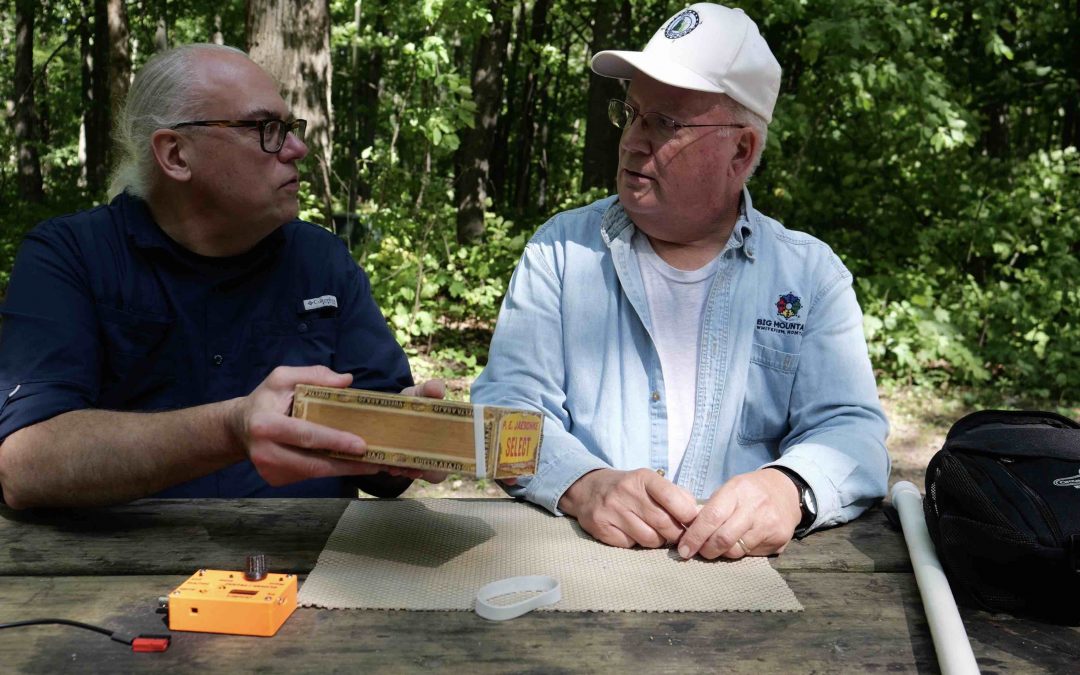We’ve probably all heard the term “Shack in a Box.” It’s used to refer to a portable amateur station where all the components are built into a large case. Typically these are 4U rack cases or roto-molded Pelican style boxes. Big items that hold lots of gear. These cases are heavy and while they may look cool when you are setting up at the Emcomm event, I feel that for true portable operation, their size is overwhelming.
Which brings us to this week’s video, Dave, KZ9V, takes the opposite approach of the large Shack in a Box in: An ENTIRE portable ham radio station in one box! https://youtu.be/eNIvf89TSf4
The box, nothing more than an old cigar box, and the transceiver, the tr(u)SDX QRP radio. Also included are batteries, cables, keyer, and a portable paddle. I think you can cram an antenna in there also, but Dave is dubious. I will prove him wrong.

The tr(u)SDX is a marvel of tiny proportions. It will do five bands, 80-20 meters, and over 5 watts of transmit power, depending on power supply. The SDR receiver and powerful processor gives it capabilities often reserved for larger full feature rigs. This is not a toy! But a tool, that will provide loads of fun for your next portable radio outing. You can purchase the rig here: https://amzn.to/45LNHj3 (affiliate link) They are even on sale at the moment.
On ground radials and elevated counterpoises
This last weekend while cruising the social channels, I found a post with a bit of confusion when it came to ground mounted radials and elevated counterpoises. The poster was asking why his ground mounted vertical antenna was having higher than average SWR on the 40m band, and the answers all came back with a lot of bad advice when it comes to radials. So here is a bit of a primer on the difference.
First off, you need to read this article from Rudy Severns, N6LF, An Experimental Look at Ground Systems for HF Verticals. (QST, March 2010, 30-33). it’s the basis for what I am going to say. https://rudys.typepad.com/files/qst-march-2010-ground-system-experiments.pdf
With a simple HF vertical antenna, you have two choices: ground mounted radials and elevated counterpoises. Both have their advantages and disadvantages, and both will get the job done. Choosing one over the other is not so much which system is better, but which does what I want it to do.

When you lay your radials on the ground, they become non resonant. That means the length of the radial will have less to do with signal strength than the overall number of radials. Severns found that adding more, shorter, radials actually had a signal strength increase over using four radials cut to a 1/4 wave length. This means two things: you don’t have to lay out extremely long radials for good low band operation, you can get by with more shorter radials. And second, since the radials are non resonant, a radial field of 8 or so shorter radials will work on multiple bands.
The way I like to think of it, is that surface area coverage is more important than resonant length. That’s why faraday cloth or window screen works great as a ground system. It is a non resonant length, and it covers a relatively large surface area.

Elevated radials on the other hand, need to be tuned, or resonant, for the frequency they are going to operate on. Two common elevated 1/4 wave antennas are the Buddistick and the KJ6ER PERformer antenna. These systems take advantage of the elevated counterpoise to increase signal strength. In the Severns’ article, he found that four elevated radials performed as well at 32 radials laying on the ground. Unless you are planning to lay a lot of radials on the ground, elevating your counterpoise will result in a greater signal strength with less effort.
So which do I choose? I like ground based verticals with 8 16 foot radials or a 3 yard sheet of faraday cloth because it deploys quickly and offers pretty good performance. According to Severns, elevating four radials 48 inches off the ground can give you up to 5 dB of signal improvement compared to four ground radials. To put that in perspective, one S-Unit on your meter is 6 dB. So there is a difference. This could help greatly in marginal band conditions, but if you are already rocking S7 and S9 signals, you may not notice the difference.
My recommendation, is to pick a method that best works for the location. If there is lots of rock or poor ground conductivity, elevate the radials for maximum performance. If you are in a swamp or on the ocean, ground mounted radials may be your best option. Above all, try both methods so you can get a better understanding how radials and counterpoises affect your portable operation performance.
Finishing Up
Radials is an important topic, so I’ll be expanding this subject into a video. If there are particular questions you have about radials, either ground or elevated, leave me a comment so I can work it into the video.
Our monthly livestream happens this Thursday September 4th at 7:00pm central time (0000Z September 5) Joe and I will be celebrating five years of monthly livestreams. I can’t believe we’ve survived this long! Get your ham radio questions ready and join us, it should be a good time. Here’s the livestream link: https://youtube.com/live/cMlWy-xBk9w?feature=share
I hope to get you in the log soon
Michael
KB9VBR

Recent Comments